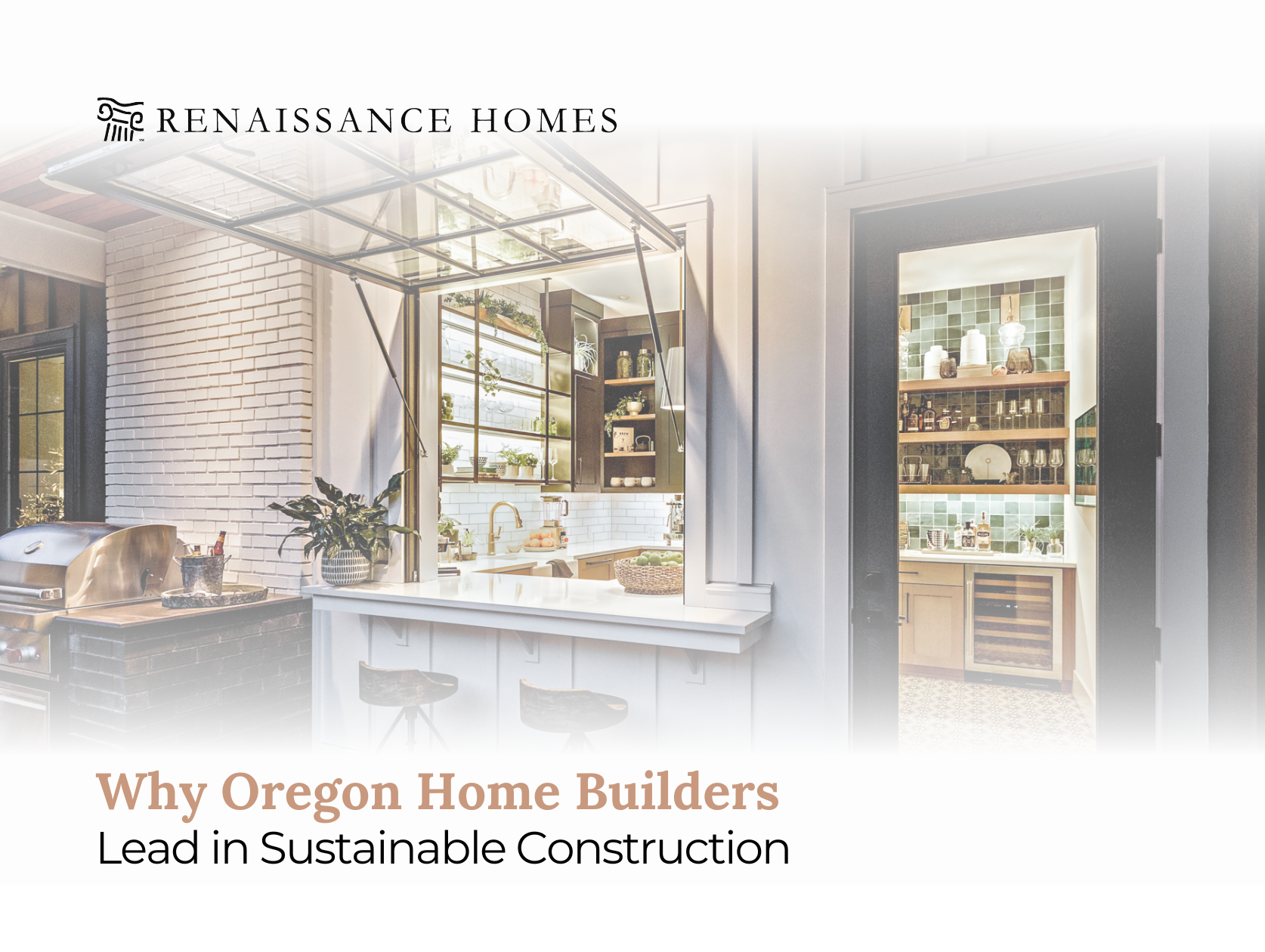Oregon home builders have established themselves as frontrunners in sustainable construction practices nationwide. The custom luxury home builder in Oregon landscape has evolved dramatically over the past decade, with luxury custom home builders in Oregon pioneering innovative approaches to environmentally conscious building. This commitment to sustainability isn’t just a passing trend but rather a fundamental shift in how homes are designed, constructed, and maintained throughout the state.
The Evolution of Sustainable Building in Oregon
Historical Context
Oregon’s relationship with sustainable building practices dates back to the 1970s environmental movement. The state’s early adoption of land use planning laws created a foundation for what would later become a thriving sustainable construction industry. These pioneering regulations helped preserve natural landscapes while encouraging thoughtful development.
The 1990s saw Oregon builders beginning to experiment with green building techniques, well before they became mainstream in other parts of the country. This early adoption positioned Oregon as a testing ground for innovative approaches that would later be implemented nationwide.
By the early 2000s, sustainable building had transitioned from a niche market to an expected standard for quality construction throughout the state, with custom home builders leading the charge in implementing new technologies and approaches.
Key Milestones in Oregon’s Sustainable Building Movement
Oregon’s journey toward sustainable construction leadership has been marked by several significant developments:
- 1993: Formation of the Oregon Natural Step Network, one of the first statewide sustainability organizations
- 2001: Portland becomes one of the first cities nationwide to adopt LEED standards for public buildings
- 2008: Oregon adopts one of the nation’s most progressive energy efficiency building codes
- 2017: Portland implements the first residential energy score disclosure policy in the nation
These milestones reflect a consistent commitment to advancing sustainable building practices across decades, creating an environment where innovation could flourish.
What Makes Oregon’s Approach Unique
Climate-Responsive Design Principles
Oregon builders have developed exceptional expertise in designing homes that respond to the state’s diverse climate conditions. From the rainy western regions to the high desert in the east, custom luxury home builders adapt sustainable techniques to local environments.
These climate-responsive approaches include passive solar design that maximizes natural heating in cold months, strategic window placement for natural cooling during summer, and advanced moisture management systems for the state’s rainy areas. This regionalized approach ensures homes are not only environmentally friendly but also comfortable and durable.
The integration of local knowledge with cutting-edge building science has created a distinctive Oregon approach to sustainable home construction that balances innovation with practicality.
Material Sourcing and Supply Chain Innovation
Oregon’s abundant forest resources have enabled a unique approach to sustainable material sourcing. The state’s home builders have developed sophisticated supply chains that prioritize locally harvested, sustainably managed timber and other regional materials.
This local sourcing strategy reduces transportation emissions while supporting regional economies. Many custom home builders have established direct relationships with local mills and manufacturers, ensuring materials meet rigorous environmental standards while maintaining high quality.
The state’s builders have also pioneered the reuse of reclaimed materials, transforming everything from old barns to decommissioned bridges into stunning architectural elements for modern homes.
Community-Centered Development Approaches
Beyond individual homes, Oregon builders have reimagined how residential communities function. Developments increasingly incorporate shared green spaces, community gardens, and integrated natural areas that preserve ecosystem functions while enhancing quality of life.
Many new communities feature walkable designs that reduce car dependency, with easy access to public transportation and daily necessities. This holistic approach considers not just the environmental impact of individual homes but the overall sustainability of entire neighborhoods.
Custom luxury home builders across the state have demonstrated that high-end construction can coexist with and enhance community-focused development, proving that sustainability and luxury aren’t mutually exclusive concepts.
Innovative Technologies and Techniques
Advanced Energy Efficiency Systems
Oregon home builders have become specialists in implementing cutting-edge energy efficiency technologies. The state’s builders routinely incorporate advanced insulation systems, high-performance windows, and sophisticated HVAC solutions that dramatically reduce energy consumption.
Many custom homes now feature “building envelope” designs that create an airtight structure, eliminating drafts and heat loss while incorporating controlled ventilation systems that maintain optimal indoor air quality. These techniques often result in homes that use 50-70% less energy than conventional construction.
The integration of smart home technology allows homeowners to monitor and optimize energy usage in real-time, furthering efficiency gains through automated systems that adjust to occupancy patterns and weather conditions.
Renewable Energy Integration
The incorporation of renewable energy systems has become standard practice for many Oregon builders. Solar installations are increasingly designed as integral components of new homes rather than afterthought additions.
Custom luxury home builders have developed expertise in aesthetically integrating solar panels into architectural designs, sometimes using solar tiles or other low-profile systems that maintain visual appeal while generating clean energy. Some innovative projects incorporate micro-hydro systems in properties with running water features or vertical wind turbines where appropriate.
Battery storage systems are increasingly paired with renewable generation, allowing homes to function independently during power outages and optimize energy usage during peak demand periods.
Water Conservation and Management
Oregon’s home builders have pioneered comprehensive water management approaches that go far beyond basic conservation. Advanced systems capture, filter, and reuse rainwater for irrigation and non-potable household uses, substantially reducing municipal water demand.
Innovative landscape designs incorporate rain gardens and bioswales that naturally filter stormwater while reducing runoff and erosion. Inside the home, high-efficiency fixtures and appliances work alongside smart water management systems that can detect leaks and monitor usage patterns.
Some cutting-edge projects have implemented blackwater treatment systems that process all household wastewater on-site, creating closed-loop systems that dramatically reduce environmental impact while providing irrigation for landscaping.
Regulatory Environment and Incentives
Progressive Building Codes
Oregon’s building codes have consistently ranked among the nation’s most progressive regarding sustainability and energy efficiency. These forward-thinking regulations have created a framework that encourages innovation while establishing minimum standards that elevate the entire industry.
Rather than resisting these regulations, many custom home builders in the state have embraced them as opportunities to differentiate themselves through expertise in meeting and exceeding code requirements. This positive relationship between regulators and builders has fostered collaborative approaches to advancing sustainable practices.
The state’s code adoption process incorporates extensive input from building professionals, creating standards that are both ambitious and practical for real-world implementation.
Financial Incentives and Support Programs
Oregon offers a comprehensive suite of financial incentives that make sustainable building features more accessible to homeowners across different budget levels. These include:
- Property tax exemptions for homes meeting high energy efficiency standards
- Rebate programs for installation of renewable energy systems
- Low-interest financing for green building features
- Cash incentives for implementing specific energy-saving technologies
These financial tools have helped mainstream sustainable building practices by offsetting initial costs while highlighting the long-term economic benefits of green construction approaches.
Education and Professional Development
The state has developed robust educational pathways for building professionals focused on sustainable construction. Specialized training programs, certifications, and continuing education opportunities ensure that Oregon’s builders remain at the cutting edge of green building knowledge.
Partnerships between industry groups, educational institutions, and government agencies have created a knowledge ecosystem that rapidly disseminates new techniques and technologies throughout the building community. This emphasis on continuous learning enables even small custom home builders to implement sophisticated sustainable approaches.
The culture of knowledge-sharing among Oregon builders has fostered a collaborative environment where sustainability innovations are refined and improved through community expertise.
Economic Impact and Job Creation
Green Building Economy
Oregon’s commitment to sustainable construction has generated a thriving economic sector focused on green building products, services, and expertise. This ecosystem includes manufacturers of sustainable building materials, specialized consultants, renewable energy installers, and numerous other professionals.
This green building economy creates thousands of jobs across the state while developing exportable expertise that positions Oregon companies as leaders in national and international markets. The economic benefits extend beyond construction itself to include ongoing maintenance, monitoring, and upgrading of sustainable systems.
Custom luxury home builders have played a crucial role in demonstrating the market viability of premium sustainable features, helping to create economies of scale that eventually make these technologies accessible to broader markets.
Property Value and Market Differentiation
Homes built with sustainable features consistently command premium prices in Oregon real estate markets. Studies show that certified green homes sell faster and at higher price points than conventional construction, creating strong market incentives for sustainability.
This market recognition has transformed sustainable building from a niche concern to a mainstream value proposition. Homebuyers increasingly expect energy efficiency, healthy indoor environments, and environmental responsibility as standard features rather than premium upgrades.
The result is a virtuous cycle where market demand drives further innovation, which in turn enhances property values and reinforces consumer expectations for sustainable construction.
Case Studies: Leading Oregon Sustainable Home Projects
Urban Infill Excellence
In Portland’s historic neighborhoods, custom home builders have mastered the art of sustainable urban infill development. These projects respect the architectural character of established neighborhoods while incorporating state-of-the-art sustainability features behind their traditional facades.
One exemplary project transformed a small urban lot into a net-zero energy home that generates more electricity than it consumes over the course of a year. The home features salvaged materials from the original structure, advanced insulation systems, and rooftop solar that powers both the home and an electric vehicle charging station.
Despite space constraints, the project incorporates extensive rainwater harvesting, native landscaping, and food production spaces, demonstrating how urban homes can contribute positively to environmental systems.
Rural Sustainability Showcase
In Oregon’s rural areas, luxury custom home builders have created showcase properties that harmonize with natural landscapes while demonstrating sustainable living principles. These homes often operate off-grid or with minimal connection to external utilities, proving the viability of self-sufficient residential design.
A standout project in the Willamette Valley incorporates rammed earth construction using soil from the building site, reducing embodied carbon while creating thermal mass that naturally regulates indoor temperatures. The home’s water comes entirely from captured rainwater, filtered and managed through an integrated system that supports both household needs and adjacent agricultural uses.
The project demonstrates how rural luxury homes can function as regenerative components of local ecosystems rather than extractive impositions on the landscape.
Suburban Transformation
In suburban contexts, Oregon builders have reimagined conventional development patterns to create more sustainable communities. These projects often retrofit existing neighborhoods with increased density, shared resources, and enhanced connection to natural systems.
An innovative development near Eugene transformed a traditional suburban subdivision by implementing shared renewable energy systems, community stormwater management, and collective food production spaces. Individual homes were retrofitted with enhanced insulation, energy-efficient systems, and smart home technology that allows residents to monitor and reduce resource consumption.
This approach proves that sustainable principles can be successfully applied to existing suburban contexts, potentially transforming the environmental performance of Oregon’s most common housing type.
Challenges and Future Directions
Addressing Affordability Concerns
As sustainable building practices have evolved, Oregon’s home building industry faces the challenge of making these approaches accessible across different price points. While luxury custom homes often showcase the most advanced features, the industry is working to adapt these innovations for more affordable housing segments.
Several builders have developed streamlined approaches that deliver core sustainability benefits at lower cost points, focusing on fundamental elements like optimized building envelopes and efficient systems rather than more expensive showcase technologies. These approaches deliver substantial environmental benefits while maintaining affordability.
Industry collaborations are exploring how economies of scale, prefabrication, and standardized sustainable components can further drive down costs while maintaining high performance standards.
Adapting to Climate Change Realities
Oregon’s builders increasingly design homes not just to reduce environmental impact but to withstand the realities of a changing climate. This includes enhanced resilience to extreme weather events, wildfire resistance in vulnerable areas, and adaptation to shifting temperature and precipitation patterns.
Forward-thinking builders incorporate features like enhanced structural systems to withstand stronger storms, non-combustible building materials and defensible space designs in fire-prone regions, and cooling strategies for buildings in areas experiencing increasing summer temperatures.
These approaches represent the evolution of sustainable building from focusing solely on reducing environmental impact to creating structures that can thrive in changing environmental conditions.
Emerging Technologies and Approaches
The next frontier for Oregon’s sustainable building industry includes several promising developments:
- Mass timber construction techniques that sequester carbon while reducing embodied energy
- Integrated renewable microgrids that allow communities to share energy resources
- Biodegradable insulation materials derived from agricultural byproducts
- Natural building approaches adapted for modern code compliance
These innovations represent continuing evolution in the state’s approach to sustainable construction, building on decades of progress while addressing emerging challenges and opportunities.
Why Renaissance Homes
Locally owned and operated for over four decades, Renaissance Homes is the custom luxury home builder trusted by the area’s most discerning buyers. We are proud to offer the highest quality, most seamless home building experience, as the most awarded builder in Street of Dreams history.
As the best custom luxury home builder in the region, Renaissance Homes transforms dreams into reality. With premium products hand-selected by our award-winning design team, every custom built home design reflects our commitment to excellence. Our custom homes building process ensures attention to every detail, while our custom luxury home plans are tailored to your unique vision. When you choose our custom home builder services, you’re investing in a work of art and a celebration of craftsmanship.
Renaissance Homes stands at the forefront of Oregon’s sustainable building movement, combining luxury with environmental responsibility. Our design studio showcases how premium materials and sustainable practices create extraordinary living spaces with available homes that demonstrate our commitment to both excellence and environmental stewardship. With land available for custom projects, we help clients realize their sustainable living dreams from concept to completion.
Frequently Asked Questions
What makes Oregon home builders different from builders in other states?
Oregon home builders have developed specialized expertise in sustainable construction due to the state’s progressive building codes, abundant natural resources, and cultural emphasis on environmental responsibility. This combination has created a building community with exceptional knowledge of climate-responsive design, local material sourcing, and advanced energy efficiency systems that often exceed practices in other regions.
How much more expensive is sustainable construction compared to conventional methods?
While sustainable homes may have 5-10% higher initial construction costs, they typically deliver significant savings through reduced energy bills, lower maintenance costs, and increased durability. Many sustainable features pay for themselves within 5-7 years, after which they provide ongoing financial benefits. Additionally, homes with green certifications often command premium resale prices, further enhancing their long-term value proposition.
What are the most important sustainable features to consider when building a custom home in Oregon?
The most impactful sustainable features for Oregon homes include a high-performance building envelope with advanced insulation and air sealing, energy-efficient heating and cooling systems appropriate for your specific climate zone, water conservation systems including rainwater harvesting where appropriate, and passive solar design elements that reduce energy demands. The optimal combination will depend on your specific location within Oregon’s diverse climate regions.
How can I find a truly knowledgeable sustainable builder in Oregon?
Look for builders with recognized green building certifications such as Earth Advantage, LEED for Homes, or Passive House training. Request to see examples of their previous sustainable projects and ask specific questions about their approach to energy efficiency, material sourcing, and indoor air quality. Reputable sustainable builders will be able to clearly explain their methods and provide references from homeowners living in their sustainable homes.
What kind of ongoing maintenance do sustainable homes require?
Properly designed sustainable homes often require less maintenance than conventional construction due to their durable materials and resilient systems. However, some specialized systems like heat recovery ventilators, solar arrays, or rainwater collection systems may need periodic professional servicing. Many builders offer monitoring systems and maintenance programs to ensure optimal performance, with most major components designed to function effectively for decades with proper care.



